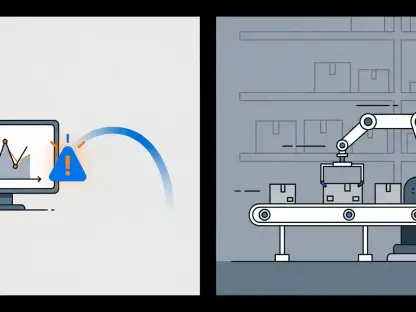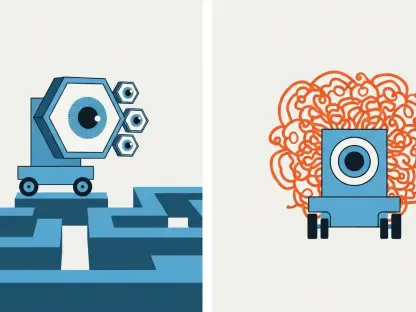In a world where healthcare systems are grappling with unprecedented demands, artificial intelligence (AI) emerges as a beacon of hope, particularly in the realm of medical imaging, offering transformative solutions. At the heart of this transformation is the pioneering work being done at CSIRO’s Australian e-Health Research Center (AEHRC), where cutting-edge technologies are being developed to support radiologists under immense pressure. With Australia facing an aging population and a surge in patient numbers, the need for efficient diagnostic tools has never been more urgent. Chest X-rays, vital for detecting critical conditions, are piling up, stretching the capacity of medical professionals to their limits. AI offers a promising solution by enhancing diagnostic precision and reducing workloads, paving the way for a more sustainable healthcare future. Yet, beyond the technological marvels, there lies a deeper commitment to ethical integration, ensuring that these tools serve as allies rather than replacements for human expertise.
Revolutionizing Diagnostic Support with AI
Easing the Burden on Radiologists
The shortage of radiologists in Australia has reached a critical point, driven by an aging demographic and a corresponding spike in demand for medical imaging services. This crisis leaves many professionals overwhelmed, struggling to keep up with the volume of chest X-rays and other scans needed to diagnose life-threatening conditions. AI steps in as a vital support system, designed to alleviate this burden by automating routine aspects of image analysis. Far from replacing radiologists, these tools aim to enhance their capabilities, allowing them to focus on complex cases and patient care. By integrating seamlessly into existing workflows, AI can prioritize urgent cases and provide preliminary insights, ensuring that human expertise remains the cornerstone of clinical decisions. This approach not only addresses immediate workload challenges but also sets a precedent for how technology can complement healthcare professionals in high-pressure environments.
Another dimension of this support lies in the scalability AI offers to meet future demands. As patient numbers continue to rise, the ability of AI to process vast quantities of imaging data quickly becomes invaluable. This technology can assist in triaging scans, flagging abnormalities for immediate review, and reducing the time spent on repetitive tasks. Importantly, the focus remains on collaboration rather than automation, with systems being fine-tuned to align with radiologists’ diagnostic styles and preferences. Such adaptability ensures that the technology is not a one-size-fits-all solution but a tailored aid that respects the nuances of medical practice. The result is a more balanced workload, where radiologists can dedicate their skills to interpretation and patient interaction, ultimately improving the quality of care across the board.
Boosting Precision Through Advanced Models
Visual-language models (VLMs), a sophisticated branch of AI, are at the forefront of transforming how medical images are interpreted. These models go beyond traditional image recognition by combining visual analysis with textual reporting, enabling the generation of detailed radiology reports for complex scans like chest X-rays. Trained on extensive datasets that include images, patient referrals, and expert reports, VLMs learn to identify patterns and anomalies with remarkable accuracy. This capability allows them to provide radiologists with actionable insights, streamlining the diagnostic process. The continuous learning aspect of these models means that their precision improves over time, adapting to new data and evolving medical standards, thus offering a dynamic tool for healthcare providers.
A significant leap in the effectiveness of VLMs comes from integrating richer contextual data into their training. By incorporating information from emergency department records—such as a patient’s chief complaints, vital signs, and medication history—these models gain a deeper understanding of individual cases. This additional context results in more accurate and relevant radiology reports, closely mirroring the nuanced assessments made by human experts. Such advancements are not merely theoretical; they are being tested in real-world settings, with promising outcomes that suggest a future where AI can reliably assist in high-stakes diagnostics. This enhanced precision underscores the potential for AI to not only support but also elevate the standard of medical imaging, ensuring better outcomes for patients through informed and timely interventions.
Prioritizing Ethics in Technological Advancements
Combating Bias for Equitable Outcomes
As AI becomes increasingly embedded in medical imaging, addressing demographic biases in training data emerges as a critical priority. If left unchecked, biased datasets can lead to disparities in diagnostic accuracy across different population groups, undermining trust in these technologies. Researchers at AEHRC are diligently working to ensure that AI tools are trained on diverse and representative data, reflecting a wide range of ethnicities, ages, and health conditions. This effort is essential to create equitable solutions that perform consistently for all patients, regardless of background. By focusing on fairness, the development process aims to eliminate systemic inequities, fostering a healthcare environment where technology serves everyone with equal reliability and effectiveness.
Equally important is the transparency in how these models are developed and deployed. Stakeholders are emphasizing the need to openly address potential biases and the steps being taken to mitigate them, which builds confidence among medical professionals and patients alike. Regular audits of AI performance across varied demographics are being implemented to identify and correct any discrepancies early on. This proactive stance not only enhances the credibility of AI applications but also sets a standard for responsible innovation in healthcare. By prioritizing inclusivity, the field moves closer to a future where technology acts as a unifying force, ensuring that advancements in medical imaging benefit the entire spectrum of society without perpetuating existing disparities.
Safeguarding Human Judgment
Central to the ethical deployment of AI in medical imaging is the unwavering commitment to a “human in the loop” approach. This principle ensures that radiologists retain ultimate authority over clinical decisions, with AI serving solely as a supportive tool rather than an independent decision-maker. Such a framework is vital for maintaining patient safety, as it leverages the irreplaceable value of human intuition and experience in interpreting nuanced medical data. By positioning AI as an assistant, the technology can highlight potential issues or suggest diagnoses, but the final call always rests with the medical professional, preserving the trust inherent in the doctor-patient relationship.
This balance between innovation and oversight also addresses concerns about over-reliance on automated systems. Continuous training and guidelines are being developed to ensure that radiologists are equipped to critically evaluate AI outputs, recognizing when to accept or override suggestions based on their expertise. This collaborative dynamic mitigates risks associated with algorithmic errors and reinforces the ethical imperative of prioritizing patient well-being over technological convenience. As AI tools become more integrated into clinical settings, this human-centric model serves as a safeguard, ensuring that advancements enhance rather than diminish the quality of care. The focus remains on empowering healthcare providers, using technology to augment their skills while upholding the highest standards of medical ethics.
Expanding the Horizons of AI in Healthcare
Diversifying Applications Beyond Diagnostics
While the spotlight often falls on AI’s role in medical imaging, its potential reaches far beyond diagnostics into other critical areas of healthcare. Visual-language models (VLMs) are being explored for their ability to process medical documents as images, rather than text, enabling rapid and efficient information retrieval. This application, spearheaded by researchers like Dr. Arvin Zhuang at AEHRC, addresses the administrative bottlenecks that often slow down healthcare delivery. By automating the extraction of key data from forms, reports, and records, AI can significantly reduce the time spent on paperwork, allowing staff to focus on patient care. This versatility highlights how a single technology can tackle diverse challenges, from clinical precision to operational efficiency.
The implications of such applications extend to improving overall healthcare system functionality. Hospitals and clinics often grapple with vast amounts of unstructured data, which can delay critical processes like patient admissions or treatment planning. AI’s ability to organize and retrieve information swiftly offers a practical solution, streamlining workflows and reducing errors associated with manual data handling. This shift not only enhances administrative efficiency but also indirectly supports better patient outcomes by ensuring that healthcare providers have timely access to accurate information. As these tools evolve, their integration into various facets of healthcare promises a more cohesive and responsive system, capable of meeting modern demands with agility and precision.
Validating Impact Through Clinical Trials
The real-world impact of AI in medical imaging hinges on rigorous testing and validation, a process already underway at facilities like Princess Alexandra Hospital in Brisbane. These clinical trials are designed to compare AI-generated radiology reports with those produced by human experts, assessing accuracy, reliability, and practical utility in live settings. Such evaluations are crucial for identifying strengths and limitations, ensuring that the technology meets the stringent requirements of medical practice. By involving actual patient data and real-time feedback from radiologists, these trials provide invaluable insights into how AI can be fine-tuned to better serve clinical needs, bridging the gap between research and application.
Expanding these efforts to additional clinical sites is a key focus for researchers, as testing across diverse environments ensures the adaptability and robustness of AI tools. Different hospitals may face unique challenges, from varying patient demographics to distinct operational constraints, and exposing AI systems to such variability strengthens their performance. This comprehensive approach to validation not only builds confidence in the technology but also informs necessary adjustments before widespread adoption. The commitment to thorough testing reflects a broader dedication to responsible implementation, ensuring that AI enhances healthcare delivery without compromising on quality or safety. As these trials progress, they lay the groundwork for a future where technology and medicine work hand in hand to address global health challenges.
Reflecting on a Responsible Path Forward
Looking back, the journey of integrating AI into medical imaging reveals a landscape of immense potential tempered by a steadfast commitment to ethics and human oversight. The strides made at AEHRC in supporting radiologists through visual-language models demonstrate how technology can address systemic pressures like staffing shortages and rising patient demands. Trials at hospitals provide critical feedback, refining these tools for real-world impact, while efforts to diversify AI applications underscore its versatility. Most notably, the focus on mitigating biases and maintaining human judgment ensures that patient trust and safety remain paramount. Moving forward, the next steps involve scaling these innovations through broader clinical testing and fostering collaboration between technologists and healthcare providers. This balanced approach promises to shape a future where AI not only transforms diagnostics but also upholds the core values of compassionate, equitable care.









